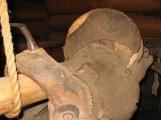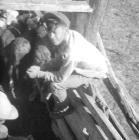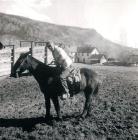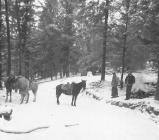1
Native CowboysNative people have been involved in the ranching industry from its very beginnings. The Native groups of British Columbia's interior had horses, brought to America in the late 15th century by the Spanish explorers, by the mid-1700s and thus became the first stock raisers in the area. The horse allowed them to cover great distances and to transport greater amounts of food and goods. By the time the early fur traders arrived, the horse was already a fixture and had become a symbol of wealth among Native peoples. Over the years, they learned the importance of good pasturage and water for the health of their animals.
By 1850, the Hudson's Bay Company at Fort Kamloops was using local Shuswap Natives as herders, drovers, agricultural workers, and packers. Their experience in raising horses, their proximity and their willingness to work made them the logical choice to take over the duties of caring for and driving the cattle. The Fort Kamloops journal refers to a man named Auxime, probably a Shuswap, taking over the cattle responsibilities.
3
The tendency to hire Natives for cattle and horse tending would prove to be one of the unique aspects of ranching in British Columbia. The ranching industry remained an "equal opportunity" employer, judging Natives and Whites alike on their ability to ride and tend cattle, rather than on the colour of their skin.The Natives soon recognized the benefits of raising horses and cattle on their own land and began to acquire their own herds. Their methods of caring for the animals were less labour-intensive than those of the HBC. Horses and cattle were left to graze on the abundant bunchgrass, and little time was spent putting up hay for winter forage during the summer. The Natives preferred horse raising to cattle raising, as the Hudson's Bay Company was always looking for additional horses to purchase or hire for its own purposes, thus providing a more steady market for the Native stock raisers than the fluctuating beef industry, and horses were much more likely than cattle to survive a severe winter that required an animal to paw through a crust of snow to get to the dried grasses beneath.
4
Native Cowboys at Pavilion20th Century
Pavilion Lake, British Columbia, Canada
 Credits:
Credits:Bill Zabotel
5
Horses thrived on the excellent bunchgrass ranges of the interior to the point where, despite winter losses, most Native groups could provide every member of the band with a mount for travel. Their equipment, and in particular their saddles, revealed the influence of the Spanish packers who worked for the HBC. Lieutenant Mayne of the Royal Engineers came through the Lillooet area in 1858 and described how the Natives made their clothing from softly tanned deer hides ornamented with beads and porcupine quills. Most significantly, they also "copied the Spanish wooden saddle for riding and made bridles of simple cord or often of the hair of the wild sheep, for it cannot be called wool, plaited. The middle of this passed through the horse's mouth and hitched around its lower jaw and the ends brought up on each side of his neck".6
Cowboy Gear - SaddleLate 1800s (?)
Hat Creek Ranch, Cache Creek, British Columbia, Canada
 Credits:
Credits:Historic Hat Creek Ranch, Liza Curran
7
The greatest transition for Aboriginal people in the area was the establishment of the cattle ranches. As their access to land and water was restricted, adjusted, and readjusted by the government, with some parcels added and others taken away, many Natives took their skills and knowledge of horses to the cattle ranches and found employment there. In many cases, a ranch was almost entirely run by Native cowboys, cooks, and maids. The Native Cowboys were welcomed as ranch hands, and one ranch owner stated "Years ago, the Indians were better cowboys than most whites would ever be".The significant involvement of the Native people shaped the ranching industry of BC's interior forever, right up to modern times.
Sources:
Mather, Ken: "Buckaroos and Mud Pups. The Early Days of Ranching in British Columbia". Heritage House Publishing Co., Surrey, BC, 2006.
Tepper, L. & Baillargeon, M. "Legends Of Our Times: Native Cowboy Life". Vancouver, UBC Press, 1947.
8
Zabotel, Vance, Celia and BillCirca 1947
Pavilion Lake, British Columbia, Canada
 Credits:
Credits:Bill Zabotel
10
Williams, ArchieCirca 1960
Hat Creek Ranch, Cache Creek, British Columbia, Canada
 Credits:
Credits:Fergie Joslin
11
Basil, SaulCirca 1961
Hat Creek Ranch, Cache Creek, British Columbia, Canada
 Credits:
Credits:Dennis Cleary

